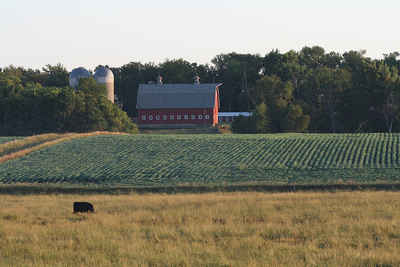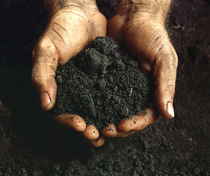South Dakota State Soil
Houdek Soil

(Cumulic Haplustolls - fine-loamy, mixed, mesic typic argiustolls)
Adopted in 1990.
To honor this natural resource, the South Dakota Legislature made Houdek (pronounced hoo-deck) the official state soil in 1990. Houdek soil is not found in any other state. It was chosen because it and closely-related soils occur on more than two million acres across South Dakota.
South Dakota State Soil: Houdek Soil

The Houdek soil, a deep, well drained, loamy soil, represents many soils formed in South Dakota under the influence of prairie grass. The dark color of the surface layer is a result of decayed plants and other materials that have been deposited over thousands of years.
The Houdek soil is of major economic importance to South Dakota because it is often used as cropland or rangeland. Small grain, corn, sunflowers,
and soybeans are commonly grown crops. Alfalfa and grass-alfalfa mixtures provide hay and pasture for grazing livestock. Large areas of the Houdek
soil are in native range. Crops and grasses grown on the Houdek soil also provide habitat for wildlife.
In South Dakota, scientists estimate that it takes Mother Nature 500 years to form ONE INCH of topsoil. Topsoil in our state ranges from 10-12 inches
thick in the east to 5-7 inches thick in the western part of the state. The range is due to climactic differences.
The Houdek series consists of very deep, well drained soils formed in glacial till on uplands. Permeability is moderate in the solum and moderately
slow in the underlying material. Slopes range from 0 to 25 percent. Mean annual precipitation is about 22 inches, and mean annual air temperature is
about 47 degrees F.
HOUDEK SERIES
The Houdek series consists of very deep, well drained soils formed in glacial till on uplands. Permeability is moderate in the solum and moderately slow in the underlying material. Slopes range from 0 to 25 percent. Mean annual precipitation is about 22 inches, and mean annual air temperature is about 47 degrees F.
TAXONOMIC CLASS: Fine-loamy, mixed, superactive, mesic Typic Argiustolls
SERIES ESTABLISHED: Spink County, South Dakota, 1955.
South Dakota Law
The law designating the Houdek soil as the official South Dakota state soil is found in the South Dakota Codified Laws, Title 1, Chapter 1-6, Section 1-6-16.4
TITLE 1 STATE AFFAIRS AND GOVERNMENT
CHAPTER 1-6 STATE EMBLEMS
1-6-16.4. State soil. Houdek soil (fine-loamy, mixed, mesic typic argiustolls) is hereby designated as the official state soil of the State of South
Dakota.
Source: SL 1990, ch 8.







